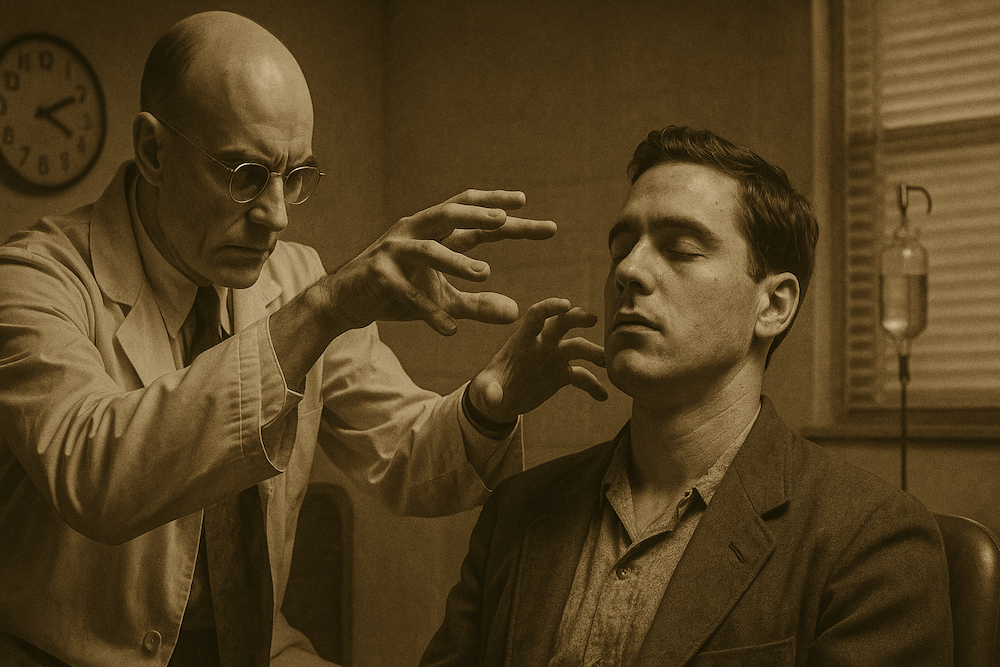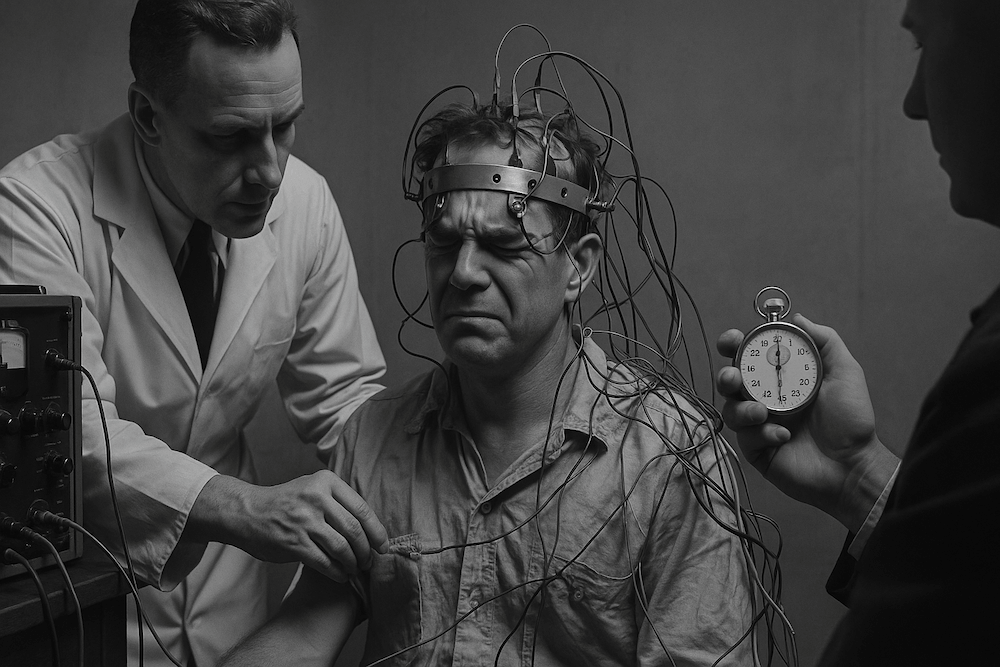Project Bluebird is one of the most disturbing programs from the early Cold War intelligence operations that are still around today. In April 1950, the Central Intelligence Agency started this secret operation. It was the start of the U.S. government's systematic study of mind control, behavioral manipulation, and psychological warfare. What began as a way to protect people from what were thought to be Soviet brainwashing techniques quickly turned into one of the most morally questionable programs in the history of American intelligence.

The Cold War: Where It Came From and What It Was
The United States was very paranoid in the early 1950s, which was a big part of why Project Bluebird was started. The Korean War started in June 1950, and reports started to come out that American POWs were being "brainwashed" by their North Korean and Chinese captors. The word itself was new to Western languages. It came from the Chinese word "xinao," which means "to wash the brain."
On April 20, 1950, Roscoe Hillenkoetter, the head of the CIA, gave the go-ahead for Project Bluebird to get money. The memo asking for permission had warnings on it that said it was very sensitive and that only a very small number of people should know about the project. The project's secret nature was so important that it went straight to the Director instead of going through the normal Projects Review Committee.
There were two reasons why the CIA did what it did. First, intelligence officials thought that the Soviet Union, China, and North Korea had come up with new ways to get information from prisoners and maybe even program people to do things against their will. Second, the Agency wanted to improve its own skills in this area, both for interrogations and for possible offensive operations. One declassified document said that the program's goal was to look into "the possibility of control of an individual by application of Special Interrogation techniques."
The Structure and Methods of Project Bluebird
Project Bluebird was meant to be a complete, integrated mind control program that worked both inside and outside of the country. The program set up special interrogation teams made up of three main people: a psychiatrist, a polygraph technician, and a hypnotist. These teams did their work while pretending to be doing regular polygraph tests, which let them do experiments without anyone noticing.
Project Bluebird used a wide range of experimental methods, many of which were very extreme. About 70% of the tests used hypnosis. Researchers tried to make "hypnotic couriers" who could remember things while in a trance and then bring them back on command without remembering the event. The goal was to make people who could get into secure places, take in sensitive information, and then forget everything that happened.
Chemical interrogation was another important part. Researchers tested a number of psychoactive drugs, such as sodium pentothal (which is often called a truth serum), morphine, mescaline, and others. Researchers gave these drugs to test subjects, often without their knowledge or consent, in an effort to weaken their mental defenses and make them more open to suggestion. The CIA wanted to find out if drugs could reliably get information from people who didn't want to give it or change their behavior in a way that could be controlled.
Project Bluebird looked into a lot of other methods besides drugs and hypnosis. Researchers looked into using electric shock therapy to cause amnesia. Researchers looked into sensory deprivation, extreme temperatures, loud noises, and lack of sleep as ways to weaken a person's will and make them more open to suggestion. The program even looked into the possibility of using viruses as weapons.
The Weak Targets
One of the most disturbing things about Project Bluebird was that it deliberately targeted people who were weak and couldn't give informed consent or protect themselves. Declassified documents and historical research indicate that around 80 percent of test subjects were psychiatric patients, individuals already in vulnerable mental states who underwent experimental procedures without their consent.

The program clearly went after a number of different types of people. Military hospitals like Bethesda Naval Hospital, Walter Reed, and Valley Forge in Pennsylvania used "special interrogation methods" on American prisoners of war who were coming back from Korea. Defectors, refugees, and foreign prisoners were also important subjects, and the program was especially interested in using these groups for testing.
Documents show that Project Bluebird teams worked in many places around the world in the 1950s. There were tests done in Europe, Japan, Southeast Asia, the Philippines, West Germany, France, and South Korea. Declassified records from West Germany show that the Artichoke team gave drugs to Russian prisoners as part of a research protocol that said "disposal of the body is not a problem." This is a chilling sign of how little the program cared about human life.
These experiments were done on thousands of people, including prisoners and people with severe mental illnesses. Many people were given experimental drugs without their permission, and some of the subjects, including children as young as five, were given LSD and other drugs that change the mind. Children as young as 11 had electrodes put in their brains. It is still hard to say how much psychological harm these victims suffered. However, the 1975 Church Committee investigation found that at least 20 percent of the subjects had lasting psychological damage.
The Move to Project Artichoke
By August 1951, Project Bluebird was well-known enough in intelligence circles that officials decided it needed a new name. The program was officially given the name Project Artichoke on August 20, 1951. This change was more than just a security measure; it was a sign that the program's scope was growing and getting more intense.
Allen Dulles joined the CIA as a consultant in 1950 and officially joined in January 1951. He was a big part of the program's growth. Dulles was very interested in the idea that science could change how people think. He thought that mind control could be the most important weapon of the future, and that any country that found ways to control people's minds could rule the world. Dulles was a big supporter of all kinds of mind control projects from the start of his CIA career to the end.
Dulles hired Sidney Gottlieb in early 1951 to run this big project. Gottlieb was a chemist with a club foot and a stutter. He was the first person the US government ever hired to find ways to control people's minds. Gottlieb led Project Artichoke in even more aggressive research into what documents called "the investigation of drug effects on ego control and volitional activities."
The main goal stayed the same: to find out if someone could be forced to try to kill someone else. A memo that was made public in January 1952 asked the most important question: "Can we get control of a person to the point where they will do what we want them to do even if it goes against their own will and even against basic laws of nature, like self-preservation?"
Project Artichoke papers show that by the early 1950s, the CIA had successfully made hypnotic couriers that worked in controlled simulations. It is still not known how much these methods were used in real operations.
The Scientific and Medical Community
Not only did a few rogue intelligence officers do bad things in Project Bluebird, but so did many important people in American psychiatry and medicine. The mind control doctors weren't just fringe practitioners; they were also presidents of the American Psychiatric Association and well-known researchers at major universities.
The CIA worked with and paid for research at 88 private institutions, such as top universities, medical centers, and hospitals. This was a widespread breach of research integrity in American colleges and universities. Researchers frequently obtained funding via CIA front organizations, often unaware of the actual intent of their work, although many were complicit in the unethical experimentation.
The participation went beyond just passive cooperation. Doctors actively gave drugs, hypnotized people, and did other experimental procedures on people who didn't know they were being tested. The experiments were part of other secret programs, such as research on chemical and biological weapons and radiation experiments. These programs were all paid for by different government agencies, such as the CIA, Army, Navy, Air Force, and even the Public Health Service.
George Estabrooks, a Harvard graduate, Rhodes Scholar, and chairman of psychology at Colgate University, is the only mind control doctor who has publicly admitted to doing a lot of hypnosis work for the CIA, FBI, and military intelligence. He bragged in the 1940s about being able to make people who were hypnotized follow orders without knowing they were doing it.
The Legacy and the Revelation
Project Bluebird was officially active from 1950 to 1951, when it was renamed Artichoke. This project then led to the even more infamous Project MKUltra in 1953. These programs stayed hidden in classified files for decades. People in the United States didn't know about these tests until the 1970s.
In 1974, journalist Seymour Hersh published an investigation in the New York Times that revealed the CIA was spying on Americans. This was the first sign that the wall of secrecy was starting to break. This led to a number of government investigations, such as the Church Committee hearings in 1975 and the Rockefeller Commission report. These reports were the first to show the public that the CIA and Department of Defense had done experiments on people who didn't know they were being used as subjects.
The news was shocking. Sidney Gottlieb, who had been in charge of these programs for 20 years, was called to testify but said he didn't remember many details. This selective memory loss was very helpful because Gottlieb had ordered the destruction of most MKUltra records, including files about Bluebird and Artichoke, in 1973. But some documents did survive. Former State Department official John Marks filed Freedom of Information Act requests that eventually led to the declassification of thousands of pages of records.
Frank Olson's case became one of the most well-known tragedies linked to these programs. In 1953, Olson, a biological warfare expert at Fort Detrick, died after falling from a hotel window on the 13th floor in New York City. This happened just days after Sidney Gottlieb gave him LSD without his knowledge. For 22 years, his family was told that he killed himself while having a psychotic episode. They didn't find out about the CIA's involvement until they read the Rockefeller Commission report from 1975. Congress eventually gave the Olson family $750,000, but this didn't bring their father back or make up for all the lies that had been told for years.
Questions that haven't been answered and ethical issues
Project Bluebird's ethical violations were very serious and happened on purpose. The program broke basic rules of medical ethics, such as the need for informed consent, the need to avoid harm, and the need to respect people's dignity and freedom. People were not treated as people with rights; they were treated as test subjects for the sake of national security.
The organized medical and psychiatric professions have not fully recognized this somber period in history. Medical schools, professional associations, and academia as a whole are also responsible for the actions of individual doctors. The acceptance of these experiments in respected institutions shows how quickly ethical lines can be crossed when they are justified by calls to duty and national security.
Many questions are still unanswered today. About 80% of Bluebird files were once secret, and about 20% were destroyed on purpose. According to data from the National Archives, declassification efforts have found about 70% of the surviving files since 2000. However, there are still big gaps in the historical record. We may never know the full extent of the operations that took place overseas, the full list of institutions that took part, or the total number of victims.
We still don't know what happened to people who were successfully conditioned or programmed. Did the CIA use hypnotic couriers or controlled killers in real missions? The files in question are still secret. What happened to the thousands of psychiatric patients and prisoners who were used in experiments? Most of them have never been recognized, compensated, or treated for the long-term psychological damage they suffered.
Relevance Today
Project Bluebird's legacy goes far beyond just being interesting from a historical point of view. The program brings up important issues about how accountable the government is, how far national security justifications can go, and how to protect human rights during times of crisis. With new worries about new technologies like AI, advances in neuroscience, and digital surveillance, the lessons of Project Bluebird are still very important.
The program showed how quickly democratic societies can give up their morals when they are scared. During the Cold War in the 1950s, people were so scared that they did things that they would never have done in peacetime. Terrorism and competition between great powers are two of today's security problems that put similar pressures on people. If people don't stay alert, these pressures could lead to ethical compromises.
Recent academic research, such as the December 2024 release by the National Security Archive and ProQuest of a thorough compilation entitled "CIA and the Behavioral Sciences: Mind Control, Drug Experiments and MKULTRA," consolidates over 1,200 critical documents pertaining to these initiatives. This ongoing effort to gather and study declassified materials makes sure that we can fully understand what happened and learn from it.
The program also shows how important it is to have strong ways to keep an eye on things. Project Bluebird's abuses happened because there was little oversight and complete secrecy. As a result of these revelations, congressional intelligence committees, inspector general offices, and protections for whistleblowers were created. It is still very important to keep and improve these protections.
Conclusion
Project Bluebird is a clear example of what can happen when the government has power without being open and accountable. The program systematically violated the rights and dignity of thousands of vulnerable individuals, all in the name of national security and fears of the Cold War. The participation of esteemed medical and scientific institutions illustrates the ease with which ethical standards can be undermined when cloaked in the rhetoric of patriotism and necessity.
The program changed from Bluebird to Artichoke to MKUltra. This shows that experiments that become normal tend to grow instead of shrink. What started as a way to protect against what they thought were enemy capabilities turned into an offensive program to make controlled human assets for intelligence operations. The main question that Project Bluebird asked is still important: Is it possible to control someone so much that they will do what we want them to do even if they don't want to? The CIA's answer, which they got through decades of unethical testing, seems to have been mostly no. But the price in human lives to find that answer was very high.
The full list of Project Bluebird's victims is still not complete because declassified documents keep coming out and historians keep putting together this hidden history. A lot of people died without knowing what had happened to them. Some people had mental scars that they could never explain. Some people, like the psychiatric patients and people who lived in institutions who made up most of the test subjects, didn't have the voice or power to tell their stories.
Project Bluebird's legacy should be a warning from the past and a reminder to always be on the lookout. In a time when neurotechnology, artificial intelligence, and security threats are always getting better, it is still very tempting to pursue technological capabilities without enough moral limits. The lesson of Project Bluebird is clear: some knowledge costs too much, and some ways of getting it go against the values that democratic societies say they stand for. Each generation has to keep those lines in place, even when there are real threats, real fears, and strong reasons to cross ethical lines in the name of safety.
References
- National Security Archive, "New Scholarly Collection on CIA Behavior Control Experiments" (2024)
- CIA Freedom of Information Act Reading Room, Project Bluebird papers (made public from 2003 to 2024)
- The United States Senate Church Committee Hearings on Intelligence Activities (1975)
- Rockefeller Commission Report on CIA Activities (1975)
- Wikipedia contributors, "Project Artichoke" and "MKUltra"
- Ross, Colin A., "Bluebird: Deliberate Creation of Multiple Personality by Psychiatrists" (2000)
- Marks, John, "The Search for the Manchurian Candidate: The CIA and Mind Control" (1979)
- Stephen Kinzer, "Poisoner in Chief: Sidney Gottlieb and the CIA Search for Mind Control" (2019)
- Archives of the Alliance for Human Research Protection
- A lot of CIA memos and papers from 1950 to 1953 that have been made public
